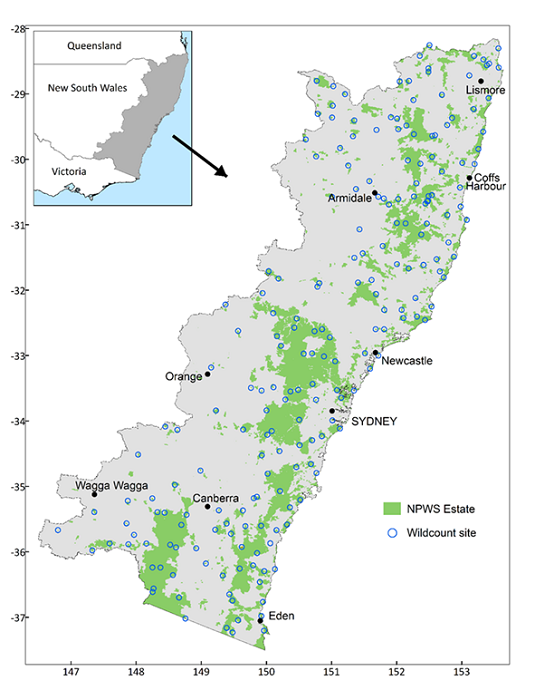Between 2012 and 2021, WildCount used motion-sensitive digital cameras at 204 sites across 146 parks and reserves in eastern New South Wales to track changes in wildlife.
WildCount was established in response to a State of the Catchments 2010: native fauna report, which identified data gaps for a range of vertebrate species in New South Wales. The report found that we did not have enough information to assess broadscale trends in even our most common species.
WildCount was designed to improve our understanding of animals on reserves by collecting data and promoting long-term monitoring of native animal trends. The program's goals were:
- detect and report changes in species distribution using annual data
- link local observations to site characteristics and model these with occupancy trends.
The data gathered helped us manage animals on reserves better by improving our knowledge on the occurrence of 27 threatened species and increasing knowledge on long-term trends in species distributions.
Where WildCount monitored wildlife
The 204 WildCount camera sites were located in 146 national parks and reserves across eastern New South Wales. Every year, 4 motion-sensing cameras were placed at each site between February and June. Cameras were left in the field for at least 2 weeks and captured over 250,000 images each year.
What did we do with all the photos?
A small team of researchers processed and reviewed every image, identifying the species captured at each WildCount site. Species lists were distributed to local staff annually.
Occupancy is a measure of the proportion of sites where each species was recorded. Ecologists analysed the data to determine species occupancy over time.
The results from the first 5 years of WildCount (2012 to 2016) were published in a mid-term report. The final 10-year report is now available to download.
Over 1.9 million animal images were captured in the WildCount program. A selection of these is available on Flickr.
What did we learn from 10 years of wildlife monitoring?
WildCount was one of the first long-term monitoring programs to survey a large suite of species across New South Wales. Over the 10 years, the program recorded 143 native mammals – including 27 threatened species – and 19 feral animal species.
WildCount had adequate data to confidently detect a 30% change in species occupancy for the common brushtail possum, swamp wallaby and red fox, although no significant trends were found over the 10 years. Mean annual rainfall was the most significant factor influencing whether some species were found at a site.
As 42% of WildCount monitoring sites were impacted by the 2019–20 bushfires, it was possible to assess immediate post-fire changes in native species occupancy. Data from 28 native species showed that most experienced no change, but 6 species – including the short-beaked echidna and Australian brush turkey – were more likely to be found at unburnt sites compared to severely burnt sites.
WildCount showed that camera-based surveys are a useful tool for long-term wildlife monitoring. The camera method proved highly effective in detecting large and medium-sized native mammals, but image quality made it difficult to reliably identify smaller mammals.
Lessons from WildCount will help shape future long-term monitoring programs by guiding the collection of robust, statistically powerful data that can support meaningful conservation outcomes.
How are we monitoring national parks now?
Long-term monitoring of species diversity and ecological health in NSW national parks and reserves is now underway through the Ecological Health Performance Scorecards program (known as Scorecards).
The Scorecards program monitors native plants and animals, soil and waterway health, as well as threats to ecological health, such as feral animals and weeds. Importantly, this information will help us make evidence-based and cost-effective decisions about park management.
Citizen science in action
From 2014 to 2020, WildCount was reliant on the dedication and support of volunteers. Each of the 6 field teams was made up of one National Parks and Wildlife Service officer and a volunteer operating across New South Wales from February to late May. Volunteers typically dedicated one full week in a season, totalling more than 11,000 volunteer hours across the life of the program.
If you are interested in volunteering with the National Parks and Wildlife Service, a wealth of amazing opportunities are available on the Volunteer Portal.
